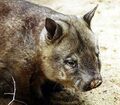Biology:Lasiorhinus
From HandWiki
Short description: Genus of marsupials
| Lasiorhinus[1] | |
|---|---|

| |
| Southern hairy-nosed wombat | |
| Scientific classification | |
| Domain: | Eukaryota |
| Kingdom: | Animalia |
| Phylum: | Chordata |
| Class: | Mammalia |
| Infraclass: | Marsupialia |
| Order: | Diprotodontia |
| Family: | Vombatidae |
| Genus: | Lasiorhinus Gray, 1863 |
| Type species | |
| Lasiorhinus mcoyi[2] Gray, 1863
| |
| Species | |
|
See text | |
Lasiorhinus is the genus containing the two extant hairy-nosed wombats, which are found in Australia . The southern hairy-nosed wombat is found in some of the semiarid to arid regions belt from New South Wales southwest to the South Australia-Western Australia border. The IUCN categorises it as Near Threatened. Conversely, the northern hairy-nosed wombat is categorised as Critically Endangered and only survives in a 3-square-kilometre (1.2 sq mi) range within the Epping Forest National Park in Queensland, but formerly also existed in Victoria and New South Wales.
Species
The genus includes the following species:
| Image | Scientific name | Common name | Distribution |
|---|---|---|---|
 |
Lasiorhinus krefftii | Northern hairy-nosed wombat | Queensland |
 |
Lasiorhinus latifrons | Southern hairy-nosed wombat | From the eastern Nullarbor Plain to the New South Wales border area |
Fossils
References
- ↑ Groves, C. P. (2005). "Genus Lasiorhinus". in Wilson, D. E.; Reeder, D. M. Mammal Species of the World: A Taxonomic and Geographic Reference (3rd ed.). Johns Hopkins University Press. pp. 43–44. ISBN 978-0-8018-8221-0. OCLC 62265494. http://www.departments.bucknell.edu/biology/resources/msw3/browse.asp?id=11000007.
- ↑ Wilson, D.E.; Reeder, D.M., eds (2005). Mammal Species of the World: A Taxonomic and Geographic Reference (3rd ed.). Johns Hopkins University Press. ISBN 978-0-8018-8221-0. OCLC 62265494. http://www.departments.bucknell.edu/biology/resources/msw3/browse.asp?id=11000007.
- ↑ "Megafauna". http://austhrutime.com/marsupial_megafauna.htm.
- ↑ "Anaspides.net". http://www.anaspides.net/earth_life_sciences/megafauna_extinction.html.
- ↑ "The Recently Extinct Plants and Animals Database cubit: The Recently Extinct Plants and Animals Database Extinct Mammals: Marsupials: Lasiorhinus angustidens". http://cubits.org/theextinctioncubit/db/extinctmammals/view/18814/.
- ↑ Johnson, Chris (2006-11-02) (in en). Australia's Mammal Extinctions: A 50,000-Year History. Cambridge University Press. ISBN 9780521686600. https://books.google.com/books?id=gcmfAgQcXDMC&q=Lasiorhinus+angustidens&pg=PA274.
- ↑ MacPhee, Ross D. E.; SUES, HANS-DIETER (2013-11-09) (in en). Extinctions in Near Time: Causes, Contexts, and Consequences. Springer Science & Business Media. ISBN 9781475752021. https://books.google.com/books?id=nkLjBwAAQBAJ&q=Lasiorhinus+angustidens&pg=PA379.
- ↑ Johnson (2002). "Determinants of loss of mammal species during the Late Quaternary 'megafauna' extinctions: life history and ecology, but not body size.". Proc. R. Soc. Lond. B 269 (1506): 2221–2227. doi:10.1098/rspb.2002.2130. PMID 12427315.
- ↑ MacPhee, R. D. E. (1999-06-30) (in en). Extinctions in Near Time. Springer Science & Business Media. ISBN 9780306460920. https://books.google.com/books?id=UZLuF1YXYTcC&q=Lasiorhinus&pg=PA251.
Wikidata ☰ Q210106 entry
 |

